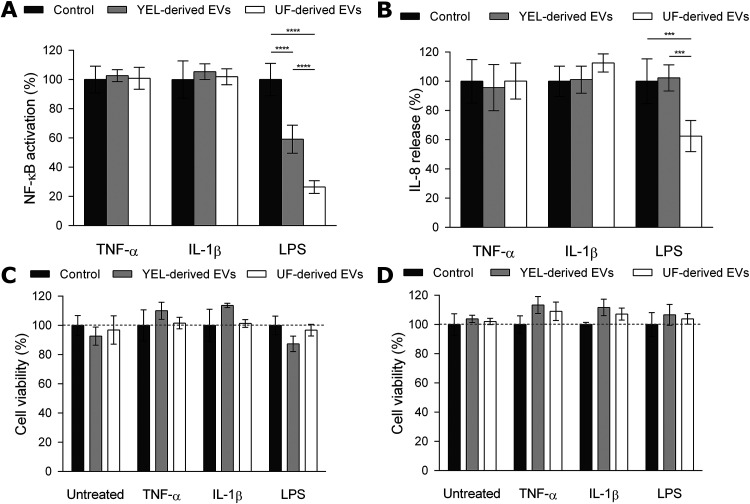FIG 2.
P. freudenreichii-secreted EVs play different biological roles depending on growth conditions. (A) Percent NF-κB transcription factor activity in HT-29/kb-seap-25 cells left untreated or treated with the inflammatory inducer TNF-α (1 ng ml−1), IL-1β (1 ng ml−1), or LPS (1 ng ml−1) in the presence or absence of UF- and YEL-derived EVs (1.0 × 109 EVs ml−1). The values are normalized by the control conditions (control TBS buffer or stimulation by the inducer in the absence of EVs). (B) Percentage of IL-8 released by HT-29 intestinal epithelial cells after stimulation by LPS (1 ng ml−1), TNF-α (1 ng ml−1), or IL-1β (1 ng ml−1) inducer in the presence or absence of UF- and YEL-derived EVs (1.0 × 109 EVs ml−1). The values are normalized to the control conditions (control TBS buffer or stimulation by inducer in the absence of EVs). (C and D) Percent viability of HT-29/kb-seap-25 reporter (left) and HT-29 parental (right) cells before or after stimulation by LPS (1 ng ml−1), TNF-α (1 ng ml−1), or IL-1β (1 ng ml−1) inducer in the presence or absence of UF- and YEL-derived EVs (1.0 × 109 EVs ml−1). The values are normalized by the control conditions (control TBS buffer or stimulation by an inducer in the absence of EVs). Data are expressed as mean ± standard deviation of values obtained from at least three independent biological replicates. Asterisks indicate statistical significance as evaluated by two-way ANOVA with Tukey's multiple-comparison test: ****, P ≤ 0.0001; ***, P ≤ 0.001.

